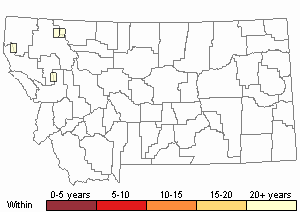View in other NatureServe Network Field Guides
NatureServe
Montana
Utah
Wyoming
Idaho
Wisconsin
British Columbia
South Carolina
Yukon
California
New York
Smith's Boat Moss - Hygrohypnum smithii
Other Names:
Smith's Hygrohypnum Moss
General Description
Plants: Pleurocarpous, typically growing in dense mats (Lawton 1971), rigid and rough, deep green to olivaceous or black, all colors sometimes dappled with golden-tinged brown or green. Stems sometimes reaching 8 cm (FNA 2014), usually 1-4 cm (Lawton 1971), freely branching or simple, the leaves broken off or only leaf base fragments remaining along the stem base, possessing a central strand; hyalodermis lacking; paraphyllia lacking (FNA 2014).
Leaves: Overlapping lightly or spreading to about 45 degrees, straight, or occasionally turned to one side of the stem, slightly contorted and shriveled when dry, spreading more when damp, flat to slightly cupped, 0.6-1.5 mm in length, 0.4-1.4 mm in width (FNA 2014), the width close to the length (Lawton 1971), not pleated, widely egg-shaped to circular, occasionally not so widely egg-shaped or deltoid, narrowing to an obtuse or curved leaf tip (FNA 2014); the base extending down the stem a little (Lawton 1971); leaf edges flat, smooth or seldom faintly and finely-toothed apically; costa typically solitary and extending to 75% of the leaf length and often forked, sometimes short and paired (FNA 2014).
Leaf Cells: Apical cells typically diamond-shaped and somewhat rounded; medial cells very slender and bending or wavy, sometimes tapered at both ends, or somewhat diamond-shaped and wavy, shorter and narrower than the basal laminal cells; margin frequently forming an obscure border consisting of short cells; alar cells oblong to square, somewhat yellowing and thick-walled, the alar region’s border obscure (FNA 2014).
Diagnostic Characteristics
Hygrohypnum molle is similar to H. smithii but is usually soft rather than coarse and rigid, and typically has its leaves intact throughout rather than broken off. Also, its costa is typically double and thin rather than typically solitary and stout (Crum and Anderson et al. 1981).
Range Comments
North American Range
Canada: BC, AB, ON, NL and NS; USA: AK, WA and CA, MT and CO (FNA 2014). Known in Montana from Flathead, Glacier, and Lincoln Counties (Elliott and Pipp 2016).
Observations in Montana Natural Heritage Program Database
Number of Observations: 6
(Click on the following maps and charts to see full sized version)
Map Help and Descriptions
Relative Density

Recency


 (Observations spanning multiple months or years are excluded from time charts)
(Observations spanning multiple months or years are excluded from time charts)
Habitat
Wet, nonbasic stone in mountain watercourses or stone and logs in slower-moving water and ponds. Ranging in altitude from 1640 to 10,170 feet (FNA 2014).
Reproductive Characteristics
Autoicous. Interior perichaetial bracts lance-shaped, pleated, the tip smooth or with several teeth, the costa solitary (FNA 2014), to 4 mm in length (Lawton 1971). Seta 8-17 mm tall, somewhat red (FNA 2014). Capsule bowed, the theca sometimes reaching 2 mm in length, contracted below the opening when dry, the neck short; endostome cilia long and knobby (Lawton 1971).
Stewardship Responsibility
References
- Literature Cited AboveLegend:
 View Online Publication
View Online Publication Crum, H.A. and L.E. Anderson. 1981. Mosses of Eastern North America. 2 volumes. Columbia University Press, New York. 1328 pp.
Crum, H.A. and L.E. Anderson. 1981. Mosses of Eastern North America. 2 volumes. Columbia University Press, New York. 1328 pp. Elliott, J.C. and A.K. Pipp. 2018. A Checklist of Montana Mosses (1880-2018). Updated 3 January, 2020. Montana Natural Heritage Program, Helena, Montana. 73 pp.
Elliott, J.C. and A.K. Pipp. 2018. A Checklist of Montana Mosses (1880-2018). Updated 3 January, 2020. Montana Natural Heritage Program, Helena, Montana. 73 pp. Flora of North America Editorial Committee, eds. 2014. Flora of North America North of Mexico. Volume 28. Bryophytes: Mosses, Part 2. Oxford University Press, Inc., NY. xxi + 702 pp.
Flora of North America Editorial Committee, eds. 2014. Flora of North America North of Mexico. Volume 28. Bryophytes: Mosses, Part 2. Oxford University Press, Inc., NY. xxi + 702 pp. Lawton, E. 1971. Moss Flora of the Pacific Northwest. Hattori Botanical Laboratory. Japan: Yamabuki-cho, Shinjuku-ku, Tokyo. 362 pages plus appendices.
Lawton, E. 1971. Moss Flora of the Pacific Northwest. Hattori Botanical Laboratory. Japan: Yamabuki-cho, Shinjuku-ku, Tokyo. 362 pages plus appendices.
- Additional ReferencesLegend:
 View Online Publication
View Online Publication
Do you know of a citation we're missing? Elliot, J. C. 1993. Second checklist of Montana mosses. Unpublished report. U.S. Forest Service, Region 1. Missoula, MT. 45 pp.
Elliot, J. C. 1993. Second checklist of Montana mosses. Unpublished report. U.S. Forest Service, Region 1. Missoula, MT. 45 pp. Flowers, S. 1973. Mosses: Utah and the West. Brigham Young University, Provo, Utah. 567 p.
Flowers, S. 1973. Mosses: Utah and the West. Brigham Young University, Provo, Utah. 567 p. Lawton, E. 1971. Keys for the Identification of the Mosses on the Pacific Northwest. Reprinted from 'Moss Flora of the Pacific Northwest'. Published as Supplement No. 2 of the Journal of the Hattori Botanical Laboratory. Nichinan, Miyazaki, Japan. 66 pp.
Lawton, E. 1971. Keys for the Identification of the Mosses on the Pacific Northwest. Reprinted from 'Moss Flora of the Pacific Northwest'. Published as Supplement No. 2 of the Journal of the Hattori Botanical Laboratory. Nichinan, Miyazaki, Japan. 66 pp. Malcolm, B., N. Malcolm, J. Shevock, and D. Norris. 2009. California Mosses. Nelson, New Zealand: Micro-Optics Press. 430 pp.
Malcolm, B., N. Malcolm, J. Shevock, and D. Norris. 2009. California Mosses. Nelson, New Zealand: Micro-Optics Press. 430 pp. Smith, A.J.E. 1980. The Moss Flora of Britain and Ireland. Cambridge University Press, Cambridge. 705 pp.
Smith, A.J.E. 1980. The Moss Flora of Britain and Ireland. Cambridge University Press, Cambridge. 705 pp.
- Web Search Engines for Articles on "Smith's Boat Moss"





